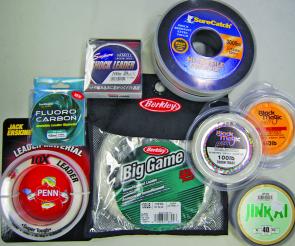As someone who works in the tackle industry I’m regularly asked questions about choosing the right leader material. There are just so many different brands, materials and variations out there and it really can leave anglers faced with a case of trial and error, which, let’s face it, is expensive and frustrating.
I first started thinking about the attributes of leader materials when I was starting out as a young journalist doing a feature on the charter vessel Elizabeth EII. Several anglers and I were fishing from the back deck of the ship and the trout were well and truly on the chew. The only problem was they kept cutting our paternoster rigs to shreds. We put our heads together and realized that the bulk spool of 70lb Trilene fishing line wasn’t hard enough to cope with the abrasive qualities of the coral bottom and trout dentures. Not to be defeated, we dug through some tackle bags and found a spool of pink leader line that had a harder outer core.
Everyone was using braid of various poundages and everyone had the same results – the leader pulled straight through the joining knot at the first hint of pressure. In my case it was the old and trusted Albright knot that slipped clean through, leaving a small curled section of braid and a bemused fisherman. We re-rigged and used towels to hold the line as we lent on the knots with the aim of setting them tightly, and still they pulled through once the fish became involved. It was around that time that we realised that the hard outer core was preventing the braid from setting into the leader. We solved the issue by using a double knot (Spider Hitch or a Bimini twist) and attaching a swivel. The leader then tied to the other side of the swivel proved to be safe and the fishing improved considerably!
This experience taught me a valuable lesson regarding super hard leaders and also the unsuitable nature of normal mono line for use as leaders in most cases. (As a side note however, I have recently found that standard Schneider line will do the job of a substitute leader, but should only be a fall back option in an emergency.) The following are several questions that I get asked regularly about leaders and I hope my answers shed some light on a frustrating topic.
Q: Why can’t I just use wire leaders? Surely if I keep getting busted off I should go for the heavy wire?
A: No, wire is a huge liability when bait fishing. It not only reduces the presentation of a bait and the ability of the angler to feel activity. It can also vibrate in the water to the extent where fish won’t come near your bait. On top of this, lures rigged with wire leader are prone to ‘blow outs’ at much lower speeds than those with mono. If you are getting bitten off, upgrade to a heavy abrasion resistant mono leader. Just remember that once you pass the 100lb breaking strain the line is usually too thick for effective knots, so have some crimps and crimping tools handy.
If you feel that you absolutely have to use wire, try changing just one of your presented lines and if you continue to catch as many fish on the outfit with wire as you do on the outfits without, then you can confidently change over.
Q: Why should I use fluorocarbon instead of mono leaders?
A: Fluorocarbon has come a long way in recent years and has also come down in price considerably. It is tough and highly abrasion resistant, but also has the added bonus of being almost invisible in the water. This is a huge advantage when the fish are spooky and/or the water is crystal clear. Another advantage of fluorocarbon is its weight. It sinks quicker through the water than normal mono lines making it ideal for working weightless stick bait lures. The forward weight of the line pulls the head of the lure down and provides a more realistic action.
Mono still has a place in every tackle box due to its price and the effective general protection it offers. I prefer to use mono leaders for most modes of bait fishing and only use the fluorocarbon when presenting lures in a slow and highly visible fashion. The exception to this is when working surface lures, as the buoyancy of mono helps to produce a natural retrieve with poppers and fizzers.
Q: What are the advantages of a supple leader?
A: Think of supple leaders as your comfort leader. They have terrific knot strength and allow for very natural bait presentation. Supple leaders often have a very tough inner core but a softer outer core, which allows for maximum grip when tying to braid or mono. It is an ideal line for using amongst timber, sand or mud and even on offshore shoals for soft-mouthed fish like nannygai and other red fish. Be warned though, after successive uses the leader with pick up nicks and abrasions which can weaken it over a long drawn out battle, so be prepared to change leaders regularly.
Tough leaders or non-abrasive style leaders are more at home amongst rocks and reefs, or when fighting toothy critters like mangrove jack. This line is usually much stiffer and can be brittle depending on the brand. It is usually coated with a hard outer layer that prevents most nicks and cuts, making for an ideal bottom bashing or trolling leader. As mentioned previously though, be wary of pulled knots and seriously consider the use of swivels and/or crimps.
Q: Why can’t I use normal line as a leader?
A: There are lots of reasons for this, but the key three are memory, abrasive resistance and design.
Firstly, many normal fishing lines have a residual memory of the tightly wound spool that has been their home. This means that your leader will end up looking like a pig’s tail, thus diminishing sensitivity and natural presentation.
Secondly, many mono lines are marketed as a blue-water line with features including decreased diameter, soft/supple movement and high visibility. This means that your leader will be soft, thin and highly visible under the water – not a good mix!
Thirdly, leaders are designed to act as your armour when you’re fishing. They exist to fill that role so there’s no point in using a less effective alternative. Let’s face it - we all want to maximize our catch.
Q: How long should my leader be?
A: A general rule of thumb, is to add 30cm to a metre to the length of fish you plan to target.
For instance, if you’re after a 30cm whiting, a 60cm trace should do the job and allow for easy casting. This is especially relevant when you consider that many pelagic species have sharp tail flukes that can cut braided line like a knife, so don’t think the teeth and gill rakers are your only problem.
The main exception to this rule is the game fishing leader. When trolling for fish on braided line, the shock created from a strike can tear the lure clean out of the fish’s mouth due to the lack of stretch in the braid. To combat this, use up to 5m of (mono) leader to provide shock absorption at the end of the braid. This also allows the deckhand to take several wraps of line when controlling a fish boat side, without losing fingers to the super thin braid.
Another thing to remember is bottom fishing rigs like paternosters will require several knots and could very well be faced with tall corals once in the strike zone. If in doubt with leader, use more!
Be aware of maximum allowed leader lengths if you are a club or tournament angler and may wish to submit a catch for official weighing.
Q: How heavy should it be?
A: Twice the poundage of your mainline is usually fine, but always have at least one heavier alternative in case of surprises.
Ok, so I hope that cleared up a few mysteries. I’m impressed with Black Magic, Jinkai and Famell leaders but there are plenty of others that are just as good. Try to keep a supply of different leader types (supple, tough and fluorocarbon) and always have a selection of breaking strains, because what works in one spot today might be too light or heavy tomorrow. As always - fish hard, stay safe and I’ll catch you on the water.
Reads: 7577
When working weightless lures like this jerk shad the weigh of a flurocarbon leader can provide a more natural action in shallow water.

With so many leaders on the market it can be a painful case of trial and error.

When chasing fish like this Sooty Grunter a supple leader is effective but be wary of the damage done by snags.

Trout like this one are equiped with teeth that can make short work of poorly chosen leaders.

Always rig high speed trolling lures with lenghts of heavy mono leader to allow for maximum mobility in the water.




